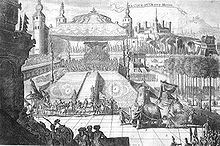- Origins of Lahore
-
A legend based on oral traditions holds that Lahore, known in ancient times as Lavapuri (City of Lava in Sanskrit),[1] was founded by Prince Lava,[2] the son of Rama, while Kasur was founded by his twin brother Prince Kusha.[3] To this day, Lahore Fort has a vacant temple dedicated to Lava (also pronounced Loh, hence Loh-awar or "The Fort of Loh") it is also believed that the buddhist-nation of Laos is derived from this name.[4]
The oldest authentic document about Lahore was written anonymously in 982. It is called Hudud-i-Alam (The Regions of the World).[5] In 1927 it was translated into English by Vladimir Fedorovich Minorsky and published in Lahore. In this document, Lahore is referred to as a small shehr (city) with "impressive temples, large markets and huge orchards." It refers to "two major markets around which dwellings exist," and it also mentions "the mud walls that enclose these two dwellings to make it one." The original document is currently held in the British Museum.[6] Lahore was called by different names throughout history. To date there is no conclusive evidence as to when it was founded. Some historians trace the history of the city as far back as 4000 years ago.[7] However, historically, it has been proved that Lahore is at least 2,000 years old. Lying on the main trade and invasion routes to South Asia, Lahore has been ruled and plundered by a number of dynasties and hordes.
In 1680's Guru Gobind Singh, a religious scholar and poet and last guru of Sikhism, told that lahore was made by Sons of Luv and kasur was made by sons of Kusha. Referred Bachitar Natak.
Contents
Claudius Ptolemeus
It was about the time referred to by Colonel Tod as the probable period of Prince Kenekson’s migration from Lahore, namely, the middle of the 2nd century that Claudius Ptolemeus, surnamed Ptolemy, the celebrated astronomer and geographer, wrote his geography, which was used as a text-book by succeeding ages. He flourished in Alexandria in 139 AD; and there is evidence of his having been alive in 161 AD. In his geography he mentions a city called Labokla, situated on the route between the Indus River and Pataliputra (Patna), in a tract of country called Kasperia (Kashmir), described as extending along the rivers Bidastes (Jhelum River), Sandabal or Chandra Bhaga (Chenab River), and Adris (Ravi River). This place, from its name and locality, Wilford would identify with Lahore. With this inference General Cunningham agrees, identifying Lahore with the Labokla of Ptolemy, and taking the first two syllables, Labo, to represent the name of Lava (or Lov), the son of Rama. The identification was, according to the same authority, first made in Kiepert’s Map of India according to Ptolemy, which accompanied Lassen’s ‘Indische Alterthums Kunde.’
Alexander Burnes
The traveller, Alexander Burnes, noticing the traditions of Cabul in his travels writes of the foundation of Lahore, “In Cabul itself there are not exactly traditions of Alexander, but both Heart and Lahore are said to have been founded by the slaves of that conqueror, whom they call a prophet. Their names were Heri (the old name of Heart) and Lahore. Candahar is said to be an older city than either of these.” But the entire absence of the name of Lahore, or any city with a name approaching it, which may be fairly identified with it, in the writings of the historians of Alexander, coupled with the fact that no coins of Indo-Bactrian or Indo-Scythic dynasties have been discovered at Lahore or in its neighbourhood, has led scholars to conclude that the city, if it existed at the time of Greek invasion, was of no importance up to, at least, the 1st century AD.
Hieun Tsang
When the celebrated Chinese pilgrim, Hieun Tsang, visited the Punjab in 630 AD, he found the walls of Sanghala completely ruined, but their foundations still remained; and in the midst of the ruins he found a small portion of the old city, still inhabited by Buddhist monks, who studied the esoteric doctrines of Buddha. According to the Chinese traveller, Taki, or Asarur (believed by General Cunningham to be the Pimparama of Alexander), about two miles to the south of the high road between Lahore and Pindi Bhattian (or 45 miles from the former and 24 from the latter), was the capital of the Punjab in AD 633.
Now, the pilgrim, in his itinerary, makes no mention of Lahore, or any city answering its name or description, though he was in Chinapatti (the modern Patti in Kasur) for 14 months, and Jalandhra (the Kulindrine of Ptolemy) for four months, and had travelled the whole country from Kashmir to Pragia, Ujjen and Kannoj. He notes that he halted for a whole month (November 633 AD) at a large town on the eastern frontier of Taki. General Cunningham would identify this large town with Kasur, as the kingdom extended to the Beas River on the east, and the great city should be looked for on the line of the Beas, and not on the Ravi.
François Bernier
François Bernier, who visited Lahore in 1664 AD, suggests its identification with the ancient Bucephals Burnes would identify Lahore with Sanghala, mentioned by Arrian and Curtius, the classical writers, as the stronghold of the Kathaean or Khatri tribe. This is the Sanghala of Alexander, mentioned also by Diadorus, and recognized as the Sakala of the Brahmans and the Sagal of the Budhists. But its position, 65 miles from the bank of the Hydraotes (Ravi), precludes the identity of its situation with that suggested by the enterprising traveller. Yet both Curtius and Arrian agree in stating that Alexander crossed the Hydraotes (Ravi) before advancing against Sanghala to punish the insurgent Kathaeans, described as a “free Indian nation.” There can, therefore, be no doubt that the conqueror crossed the Ravi in the immediate neighbourhood of Lahore, which “was most probably the position of his camp when he heard of the recusancy of the Kathaean.” But it must have been a place of no importance at the time of the Macedonian invasion, or it would have, doubtless, been mentioned by the Greek writers.
Thornton
From the mention, however, of the name of Lahore in the geography of Ptolemy before mentioned, T.H. Thornton, a distinguished British official and secretary to the Punjab government in the 1860s, approximately fixes the date of its foundation “at the end of the first or the beginning of the second century of the Christian era.” If we review history, the city was founded, deserted and re-founded several times during the course of ages before it attained the state of historic continuity under the Muslims.[8]
Conclusion
The manner in which the name has passed through various layers of history shows that there is something in the name, which could withstand the vicissitudes of changing times; and could with adaptation take over new forms to satisfy the urges and aspirations of the people of various ages. The lure and luster that attaches to the name of Lahore is not the work of one man; it is a heritage that has been enriched by the contributions of various people at different stages of history.[9][10]
Notes
- ^ Bombay Historical Society (1946). Annual bibliography of Indian history and Indology, Volume 4. p. 257. http://books.google.com/books?id=FAS2AAAAIAAJ&q=Lahore+Lavapuri&dq=Lahore+Lavapuri&ei=Fb8gStypC5byygSTlt27Dw&pgis=1. Retrieved 2009-05-29.
- ^ Baqir, Muhammad (1985). Lahore, past and present. B.R. Pub. Corp. pp. 19–20. http://books.google.com/books?id=-pAcAAAAMAAJ&q=Lahore+Lava&dq=Lahore+Lava&ei=x78gSqXAIYWKygTqtNXmAg&pgis=1. Retrieved 2009-05-29.
- ^ Nadiem, Ihsan N (2005). Punjab: land, history, people. Al-Faisal Nashran. p. 111. http://books.google.com/books?id=pyFuAAAAMAAJ&q=Kasur+Kusha&dq=Kasur+Kusha&ei=9rwgSritBZWQyASHk7maDw&pgis=1. Retrieved 2009-05-29.
- ^ Naqoosh, Lahore Number 1976
- ^ HUDUD AL-'ALAM 'The Regions of the World' A Persian Geography
- ^ Dawn Pakistan - The 'shroud' over Lahore's antiquity
- ^ "Glasgow gets a new twin in Lahore". Living in Glasgow. 14 September 2006. https://www.glasgow.gov.uk/en/News/Archives/2006/September/GlasgowLahoreTwinning.htm. Retrieved 2009-07-06.
- ^ Lahore - as in the 19th Century
- ^ About Lahore
- ^ Lahore - Paris of the East
Categories:
Wikimedia Foundation. 2010.



